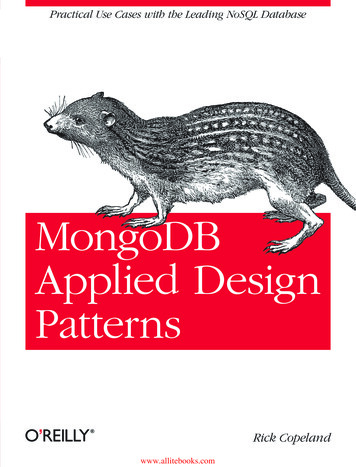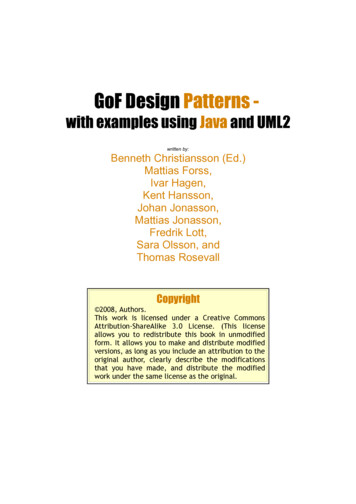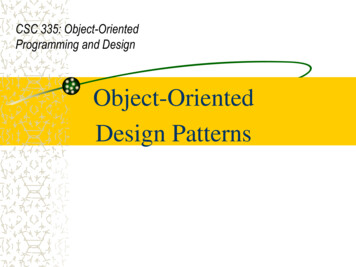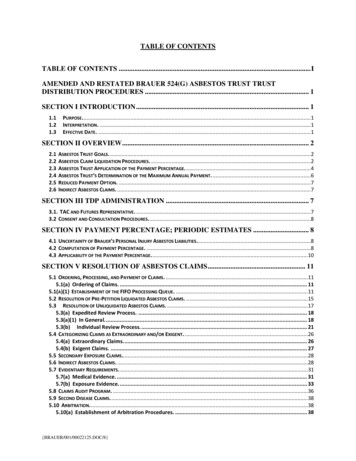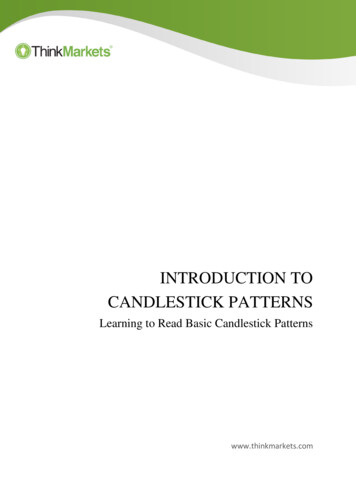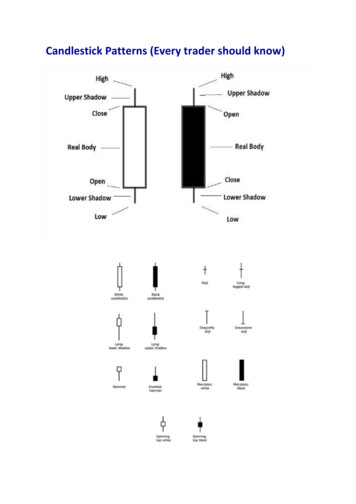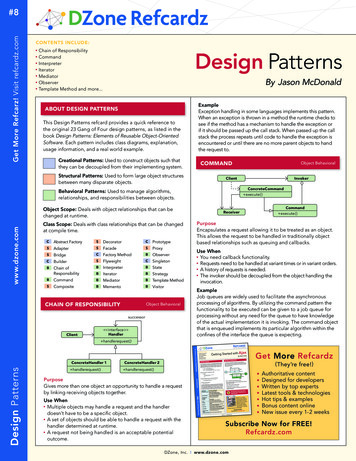
Transcription
Get More Refcarz! Visit refcardz.com#8CONTENTS INCLUDE:nnnnnnnChain of serverTemplate Method and more.Design PatternsBy Jason McDonaldExampleException handling in some languages implements this pattern.When an exception is thrown in a method the runtime checks tosee if the method has a mechanism to handle the exception orif it should be passed up the call stack. When passed up the callstack the process repeats until code to handle the exception isencountered or until there are no more parent objects to handthe request to.ABOUT DESIGN PATTERNSThis Design Patterns refcard provides a quick reference tothe original 23 Gang of Four design patterns, as listed in thebook Design Patterns: Elements of Reusable Object-OrientedSoftware. Each pattern includes class diagrams, explanation,usage information, and a real world example.Creational Patterns: Used to construct objects such thatthey can be decoupled from their implementing system.COMMANDStructural Patterns: Used to form large object structuresbetween many disparate objects.Clientwww.dzone.comObject Scope: Deals with object relationships that can bechanged at runtime.Abstract idgeCFactory MethodBObserverCBuilderSFlyweightCSingletonBChain gyBCommandBMediatorBTemplate MethodSCompositeBMementoBVisitorCHAIN OF RESPONSIBILITYPurposeEncapsulates a request allowing it to be treated as an object.This allows the request to be handled in traditionally objectbased relationships such as queuing and callbacks.Use WhenYou need callback functionality.Requests need to be handled at variant times or in variant orders.A history of requests is needed.The invoker should be decoupled from the object handling theinvocation.nnnnExampleJob queues are widely used to facilitate the asynchronousprocessing of algorithms. By utilizing the command pattern thefunctionality to be executed can be given to a job queue forprocessing without any need for the queue to have knowledgeof the actual implementation it is invoking. The command objectthat is enqueued implements its particular algorithm within theconfines of the interface the queue is expecting.Object Behavioralsuccessor interface HandlerClientCommand execute ( )ReceiverClass Scope: Deals with class relationships that can be changedat compile time.SInvokerConcreteCommand execute( )Behavioral Patterns: Used to manage algorithms,relationships, and responsibilities between objects.CObject Behavioral handlerequest( )tech facts at your fingertipsDesign PatternsConcreteHandler 1 handlerequest( )Get More RefcardzConcreteHandler 2(They’re free!) handlerequest( )nPurposeGives more than one object an opportunity to handle a requestby linking receiving objects together.nnMethod Nameopen(method, url, async)onreadystatechangeUse WhenMultiple objects may handle a request and the handlerdoesn’t have to be a specific object.A set of objects should be able to handle a request with thehandler determined at runtime.A request not being handled is an acceptable potentialoutcome.a URLopen a connection to(GET, POST, etc.)method HTTP verbinclude querystringurl url to open, mayasynchronous requestasync whether to ponseHeadenHotTipas callback (similar to onclick,assign a function objectevent model)onload, etc. in browsersetRequestHeader(namevalue)nadd a header to the HTTPntech facts atyour fingertipsrequestnsend the requestas request bodybody string to be usedfor the responsestop the XHR from listening(only populated after send()stage in lifecycle of responseis called)after(integer, only populatedThe HTTP return codeloaded state)response reaches theset afterJavaScript string (onlybody of response as ainteractive readyState)thereachesresponse(onlyas a XML document objectbody of the responsethe interactive readyState)set after response reachesread a response headernby nameGet an array of all responsenheader namesSubscribe Now for FREE!Refcardz.comnDZone, Inc.Parameters and DescriptionsAuthoritative contentDesigned for developersWritten by top expertsLatest tools & technologiesHot tips & examplesBonus content onlineNew issue every 1-2 weeks www.dzone.com
2Design Patternstech facts at your fingertipsINTERPRETERMEDIATORClass BehavioralClientObject BehavioralMediatorinforms interface Colleague interface AbstractExpressionContext interpret( ) TerminalExpressionNonterminalExpression interpret( ) : Context interpret( ) : ows loose coupling by encapsulating the way disparate sets ofobjects interact and communicate with each other. Allows for theactions of each object set to vary independently of one another.PurposeDefines a representation for a grammar as well as a mechanismto understand and act upon the grammar.Use WhenThere is grammar to interpret that can be represented aslarge syntax trees.The grammar is simple.Efficiency is not important.Decoupling grammar from underlying expressions is desired.Use WhenCommunication between sets of objects is well definedand complex.Too many relationships exist and common point of controlor communication is needed.nnnnnnExampleMailing list software keeps track of who is signed up to themailing list and provides a single point of access through whichany one person can communicate with the entire list. Withouta mediator implementation a person wanting to send a message to the group would have to constantly keep track of whowas signed up and who was not. By implementing the mediatorpattern the system is able to receive messages from any pointthen determine which recipients to forward the message on to,without the sender of the message having to be concerned withthe actual recipient list.ExampleText based adventures, wildly popular in the 1980’s, providea good example of this. Many had simple commands, suchas “step down” that allowed traversal of the game. Thesecommands could be nested such that it altered their meaning.For example, “go in” would result in a different outcome than“go up”. By creating a hierarchy of commands based uponthe command and the qualifier (non-terminal and terminalexpressions) the application could easily map many commandvariations to a relating tree of actions.ITERATORupdatesObject BehavioralMEMENTOObject BehavioralClient interface Aggregate createIterator( )Concrete Aggregate createIterator( ) : Context interface IteratorMemento-stateCaretaker next( )ConcreteIteratorOriginator next ( ) : Context-state setMemento(in m : Memento) createMemento( )PurposeAllows for access to the elements of an aggregate objectwithout allowing access to its underlying representation.PurposeAllows for capturing and externalizing an object’s internalstate so that it can be restored later, all without violatingencapsulation.Use WhenAccess to elements is needed without access to the entirerepresentation.Multiple or concurrent traversals of the elements are needed.A uniform interface for traversal is needed.Subtle differences exist between the implementation detailsof various iterators.nUse WhenThe internal state of an object must be saved and restoredat a later time.Internal state cannot be exposed by interfaces without exposingimplementation.Encapsulation boundaries must be preserved.nnnnnExampleThe Java implementation of the iterator pattern allows users totraverse various types of data sets without worrying about theunderlying implementation of the collection. Since clients simplyinteract with the iterator interface, collections are left to definethe appropriate iterator for themselves. Some will allow full access to the underlying data set while others may restrict certainfunctionalities, such as removing items.DZone, Inc.nExampleUndo functionality can nicely be implemented using thememento pattern. By serializing and deserializing the state ofan object before the change occurs we can preserve a snapshotof it that can later be restored should the user choose to undothe operation. www.dzone.com
3Design Patternstech facts at your fingertipsSTRATEGYObject BehavioralContext interface Subjectnotifies interface Observer attach(in o : Observer) detach(in o : Observer) notify( )ConcreteSubject-subjectState interface Strategy update( ) execute( )ConcreteObserver-observerState update ( )observesConcreteStrategyB execute( )Use WhenThe only difference between many related classes is theirbehavior.Multiple versions or variations of an algorithm are required.Algorithms access or utilize data that calling code shouldn’tbe exposed to.The behavior of a class should be defined at runtime.Conditional statements are complex and hard to maintain.Use WhenState changes in one or more objects should trigger behaviorin other objectsBroadcasting capabilities are required.An understanding exists that objects will be blind to theexpense of notification.nnnnnnnExampleThis pattern can be found in almost every GUI environment.When buttons, text, and other fields are placed in applicationsthe application typically registers as a listener for those controls.When a user triggers an event, such as clicking a button, thecontrol iterates through its registered observers and sends anotification to each.STATEConcreteStrategyA execute( )PurposeDefines a set of encapsulated algorithms that can be swappedto carry out a specific behavior.PurposeLets one or more objects be notified of state changes in otherobjects within the system.nExampleWhen importing data into a new system different validationalgorithms may be run based on the data set. By configuring theimport to utilize strategies the conditional logic to determinewhat validation set to run can be removed and the import can bedecoupled from the actual validation code. This will allow us todynamically call one or more strategies during the import.Object BehavioralTEMPLATE METHODClass Behavioral ContextObject Behavioral OBSERVER request ( )AbstractClass interface State templateMethod( )#subMethod( ) handle( )ConcreteState 1 handle ( )ConcreteClassConcreteState 2 subMethod( ) handle ( )PurposeIdentifies the framework of an algorithm, allowing implementingclasses to define the actual behavior.PurposeTies object circumstances to its behavior, allowing the objectto behave in different ways based upon its internal state.Use WhenA single abstract implementation of an algorithm is needed.Common behavior among subclasses should be localized to acommon class.Parent classes should be able to uniformly invoke behavior intheir subclasses.Most or all subclasses need to implement the behavior.Use WhenThe behavior of an object should be influenced by its state.Complex conditions tie object behavior to its state.Transitions between states need to be explicit.nnnnnnExampleAn email object can have various states, all of which willchange how the object handles different functions. If the stateis “not sent” then the call to send() is going to send the messagewhile a call to recallMessage() will either throw an error or donothing. However, if the state is “sent” then the call to send()would either throw an error or do nothing while the call torecallMessage() would attempt to send a recall notificationto recipients. To avoid conditional statements in most or allmethods there would be multiple state objects that handle theimplementation with respect to their particular state. The callswithin the Email object would then be delegated down to theappropriate state object for handling.DZone, Inc.nExampleA parent class, InstantMessage, will likely have all the methodsrequired to handle sending a message. However, the actualserialization of the data to send may vary depending on theimplementation. A video message and a plain text messagewill require different algorithms in order to serialize the datacorrectly. Subclasses of InstantMessage can provide theirown implementation of the serialization method, allowing theparent class to work with them without understanding theirimplementation details. www.dzone.com
4Design Patternstech facts at your fingertipsBRIDGEObject Behavioral interface VisitorAbstractionClient visitElementA(in a : ConcreteElementA) visitElementB(in b : ConcreteElementB) operation( ) interface Element accept(in v : eImplementorB operationImp( ) operationImp( )PurposeDefines an abstract object structure independently of theimplementation object structure in order to limit coupling.ConcreteElementB accept(in v : Visitor)PurposeAllows for one or more operations to be applied to a set of objectsat runtime, decoupling the operations from the object structure.Use WhenAbstractions and implementations should not be bound atcompile time.Abstractions and implementations should be independentlyextensible.Changes in the implementation of an abstraction shouldhave no impact on clients.Implementation details should be hidden from the client.nUse WhenAn object structure must have many unrelated operationsperformed upon it.The object structure can’t change but operations performedon it can.Operations must be performed on the concrete classes of anobject structure.Exposing internal state or operations of the object structureis acceptable.Operations should be able to operate on multiple objectstructures that implement the same interface sets.nnnnnnExampleThe Java Virtual Machine (JVM) has its own native set of functionsthat abstract the use of windowing, system logging, and bytecode execution but the actual implementation of these functionsis delegated to the operating system the JVM is running on.When an application instructs the JVM to render a window itdelegates the rendering call to the concrete implementationof the JVM that knows how to communicate with the operatingsystem in order to render the window.nnExampleCalculating taxes in different regions on sets of invoices wouldrequire many different variations of calculation logic. Implementinga visitor allows the logic to be decoupled from the invoices andline items. This allows the hierarchy of items to be visited by calculation code that can then apply the proper rates for the region.Changing regions is as simple as substituting a different visitor.ADAPTERCOMPOSITE operation( )Object Structural interface ComponentClass and Object Structural interface Adapter operation( ) add(in c : Component ) remove(in c : Component ) getChild(in i : ptee operation( ) interface Implementor operationImp( ) visitElementA(in a : ConcreteElementA) visitElementB(in b : ConcreteElementB)ConcreteElementA accept(in v : Visitor)Object Structural VISITOR operation( )Adaptee adaptedOperation ( )PurposeFacilitates the creation of object hierarchies where each objectcan be treated independently or as a set of nested objectsthrough the same interface.PurposePermits classes with disparate interfaces to work together bycreating a common object by which they may communicateand interact.Use WhenHierarchical representations of objects are needed.Objects and compositions of objects should be treated uniformly.Use WhenA class to be used doesn’t meet interface requirements.Complex conditions tie object behavior to its state.Transitions between states need to be explicit.nnnExampleSometimes the information displayed in a shopping cart is theproduct of a single item while other times it is an aggregationof multiple items. By implementing items as composites we cantreat the aggregates and the items in the same way, allowing usto simply iterate over the tree and invoke functionality on eachitem. By calling the getCost() method on any given node wewould get the cost of that item plus the cost of all child items,allowing items to be uniformly treated whether they were singleitems or groups of items.nnExampleA billing application needs to interface with an HR application inorder to exchange employee data, however each has its own interface and implementation for the Employee object. In addition, theSSN is stored in different formats by each system. By creating anadapter we can create a common interface between the two applications that allows them to communicate using their native objectsand is able to transform the SSN format in the process.DZone, Inc. operation( ) add(in c : Component ) remove(in c : Component ) getChild(in i : int) www.dzone.com
5Design Patternstech facts at your fingertipsFLYWEIGHTObject Structural interface ComponentConcreteComponent interface FlyweightFlyweightFactory operation( ) operation ( )Object Structural getFlyweight(in key)Decorator DECORATOR operation( in extrinsicState)Client operation( -addedState operation ( in extrinsicState) operation ( ) addedBehavior ( )UnsharedConcreteFlyweight-allState operation ( in extrinsicState)PurposeAllows for the dynamic wrapping of objects in order to modifytheir existing responsibilities and behaviors.PurposeFacilitates the reuse of many fine grained objects, making theutilization of large numbers of objects more efficient.Use WhenObject responsibilities and behaviors should be dynamicallymodifiable.Concrete implementations should be decoupled fromresponsibilities and behaviors.Subclassing to achieve modification is impractical or impossible.Specific functionality should not reside high in the object hierarchy.A lot of little objects surrounding a concrete implementation isacceptable.Use WhenMany like objects are used and storage cost is high.The majority of each object’s state can be made extrinsic.A few shared objects can replace many unshared ones.The identity of each object does not matter.nnnnnnExampleSystems that allow users to define their own application flowsand layouts often have a need to keep track of large numbers offields, pages, and other items that are almost identical to eachother. By making these items into flyweights all instances of eachobject can share the intrinsic state while keeping the extrinsicstate separate. The intrinsic state would store the shared properties,such as how a textbox looks, how much data it can hold, andwhat events it exposes. The extrinsic state would store theunshared properties, such as where the item belongs, how toreact to a user click, and how to handle events.nnnExampleMany businesses set up their mail systems to take advantage ofdecorators. When messages are sent from someone in the companyto an external address the mail server decorates the originalmessage with copyright and confidentiality information. As longas the message remains internal the information is not attached.This decoration allows the message itself to remain unchangeduntil a runtime decision is made to wrap the message withadditional information.FACADEPROXYObject StructuralFacadeObject StructuralClient interface SubjectComplex System request( )RealSubject request( )Proxy request( )PurposeAllows for object level access control by acting as a pass throughentity or a placeholder object.PurposeSupplies a single interface to a set of interfaces within a system.Use WhenThe object being represented is external to the system.Objects need to be created on demand.Access control for the original object is required.Added functionality is required when an object is accessed.Use WhenA simple interface is needed to provide access to a complexsystem.There are many dependencies between system implementationsand clients.Systems and subsystems should be layered.nnnnnnExampleLedger applications often provide a way for users to reconciletheir bank statements with their ledger data on demand, automating much of the process. The actual operation of communicatingwith a third party is a relatively expensive operation that should belimited. By using a proxy to represent the communications objectwe can limit the number of times or the intervals the communication is invoked. In addition, we c
Structural Patterns: Used to form large object structures between many disparate objects. Behavioral Patterns: Used to manage algorithms, relationships, and responsibilities between objects. CHAIN OF RESPONSIBILITY Object Behavioral Purpose Gives more than one object an opportunity to handle





